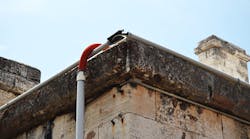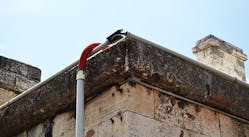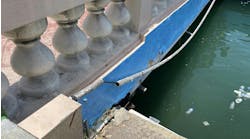How well do you know the Code? Think you can spot violations the original installer either ignored or couldn't identify? Here's your chance to moonlight as an electrical inspector and second-guess someone else's work from the safety of your living room or office. It's your turn to identify the violation.
Hint: Not so fun in the sun
Find the Answer
I find this stuff even when I’m on vacation. Thankfully, my wife appreciates my passion for this work so she doesn’t mind when I break away for a moment to capture a few pictures of Code violations like this. Finding failed PVC installations is a favorite of mine when I’m walking around outside. This is a great example of what not to do.
The broken conduit body could have been a result of thermal expansion and contraction of the PVC conduit. If expansion fittings are not used or are installed incorrectly, broken pipes and end fittings are a common result. This pipe run had no expansion fittings in it. Section 352.44 requires the use of expansion fittings when the length change of the pipe is expected to be ¼ in. or greater between securely mounted items such as boxes, elbows, or other conduit terminations.
In addition, the support requirements of Sec. 352.30 apparently were not followed to closely either, since some of the PVC pipes had no clips at all!
Unless listed for this purpose, the use of the orange ENT in this sun-exposed location is a violation of Sections 110.3(B), 362.12(8) and perhaps 800.3(D), if it is being used as a communications raceway.





